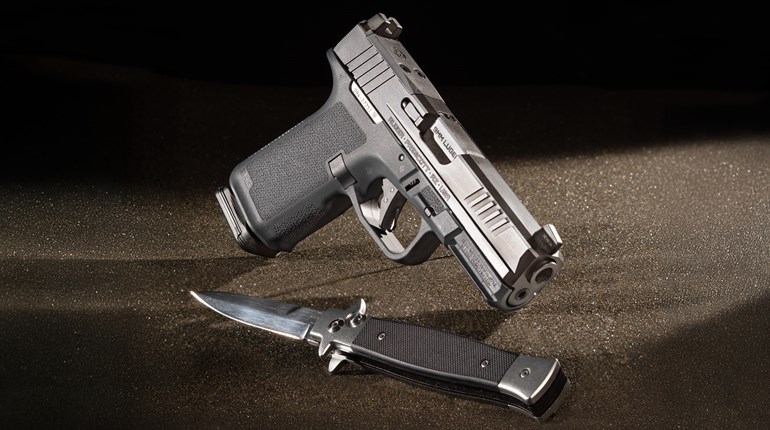
I have been in practice as a psychologist for a long time, and have seen old trends become new again, and new spins on old ideas. One example of a fad that’s relevant to self-defenders is the expansion of the familiar phrase “fight or flight” to include some new “F” words (and don’t worry, this article will remain “family friendly”). Some of the additions have included fawn, friend, flood, freeze, flop and fatigue. Although none of these additions is actually new to the way we respond when threatened, knowing your response type to crisis is important. You will need to understand yourself to increase your response options.
I’ll start by breaking down the physical side of self-defense, which is called the defense cascade. The five steps of a defense cascade include: arousal (muscle tone, heart rate and breathing rate increase), fight or flight (an active defense response), freezing (which is fight or flight on hold), tonic immobility (loss of muscle tone, inability to move or speak, shutting down), and finally, quiescent immobility (a state of rest and healing occurring after the danger). I wrote about these in a previous article called, “Self Defense for Women: Turn your Lizard Brain into a Wizard Brain.” These steps are deeply rooted in us biologically. They make up the basic responses of all humans to threats. The new F words are just further descriptors.
Step One: Arousal. In order to start the process, we have to perceive a threat. Once the threat is perceived, the brain and body start working a little differently.
Step Two: Fight or Flight. If step two sounds like a choice, you are right. We get to choose (if we know ourselves and practice) whether to stay and fight, to run away, or to not make the choice yet. If we choose to run away, we still have choices. I believe fawn and friend are simply subcategories under fight.
Fawn can be described as a response to threats that are learned through trauma experiences. An example may be that a mother in a domestic violence situation tries to please the aggressor in every way possible just to spare the children from the same abuse. In fawning we are indeed fighting using manipulation. We are behaving in ways that would reduce the aggression and threat through being friendly and trying to please the aggressor. This is a way to fight and survive even though it may not look like fighting. Don’t knock it, as it can work. No one knows what kind of situation they may end up in.
Friend is described as feeling helpless and asking or manipulating others into helping. If I lack the skills to do a certain job, I may wait until my friend who does this sort of thing helps me out. When channeled appropriately, it can create an opportunity for teamwork.
Flood is described as being utterly overwhelmed with emotion. A person may become hysterical and panicked. This most often is a flight response and is a split from parts of reality, while experiencing only the internal deluge of emotion.
Step Three: Freeze. Freezing may occur because you have decided that you haven’t been seen by the aggressor and you need to blend in to the background. Maybe it occurs because fight and flight are not available or reasonable in the situation. Maybe freeze is just your “go to.” Flooding may also be involved in freeze as well as flight. Don’t knock freeze either. All of the defense cascade responses are there because they have worked as tools to survive.
Step Four: Tonic Immobility. This has been called flop because some people will pass out.
Step Four: Quiescent Immobility. This could be called fatigue. This occurs when we have run out of adrenalin and maybe the threat is over. When arousal kicks in, we power up. This helps us react quickly and efficiently. We also get a bit of endorphins to help us forget about pain. But when those run out, we are spent.
So now that we have learned that there is nothing really new, what do we do with new terms like fawn, friend, flood, freeze, flop and fatigue? Well, we learn from them. We need to have every tool of survival available. If any of the F words is working to keep you alive in the moment, by all means, use it until escape, rescue or a better defense can be mustered.
We all have preexisting ideas about ourselves and the world. This leaves us stuck in only imagining certain ways to respond in stressful situations. If you have been through trauma, you can be triggered to respond in certain set ways. These responses may even leak into our everyday lives, changing the way we behave in relationships and changing our personality.
Learning about ourselves and training many different skills can help us add tools to our survival tool belt and expand our skills. If you have a gut feeling that it will give you an advantage in a life-or-death situation, feel free to fawn, friend, flop, flee or freeze. If you believe that you are stuck in your response style, train for other possibilities. If you are still stuck, ask a therapist to help you uncover the problem areas and unstick them. It will allow you many more options, and may even make you healthier.
The author is an MA, WV Licensed Psychologist, Licensed Professional Counselor WV, Nationally Certified Counselor, NRA Instructor, Outdoor Writer















































